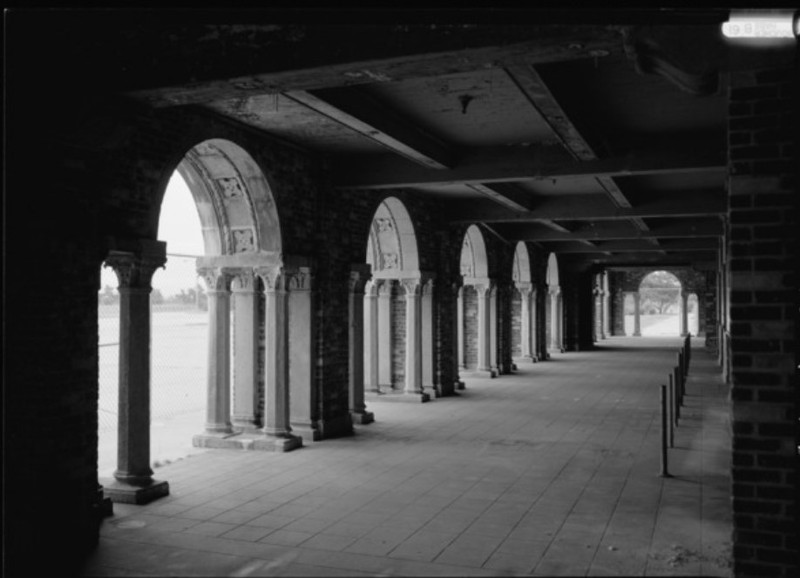Jacob Riis Park Bathhouse
Introduction
Text-to-speech Audio
The large brick structure closest to the ocean at Jacob Riis Park, south of Rockaway Beach Blvd. and north of Jacob Riis Park Promenade, is the Bathing Pavilion, or the Bathhouse. It is one of the three main historical structures in the Jacob Riis Park National Register Historic District. The Bathhouse was built in 1932 and added onto in 1936 to 1937 in Art Deco style. The historic district is significant as an example of a publicly planned and designed municipal bathing beach.
Images
South side of central portion of Riis Park Bathhouse viewed from the beach in 1990 (Jack Boucher)

Looking west down the front (north) arcade of Riis Park Bathhouse in 1990 (Jack Boucher)

South facade of Bathhouse looking northeast from Jacob Riis Park Promenade (boardwalk) in 1978 (Unrau 1981: 275)

Bathhouse (blue arrow) on 1981 map of Riis Park structures (Unrau 1981 p. xii)

Key to numbered structures on 1970s map of Jacob Riis Park (Unrau 1981 p. xiii)

View of beach from rear steps of Jacob Riis Park Bathhouse ca. 1937-1942 (National Archives, in Unrau 1981 p. 267)

Backstory and Context
Text-to-speech Audio
In 1912, New York City bought the site where Jacob Riis Park is now and named it Seaside Beach. The name was changed to Jacob Riis Park in 1915 in honor of a recently-deceased Danish photojournalist and activist; his images of slum living conditions in New York helped spur efforts toward better housing for the poor. A design competition for the park's outdoor spaces was won by landscape architect Carl Pilat but most of the ambitious design - including a bandstand and four boathouses - was not implemented. The city granted hundreds of one-day camping permits for the park in 1916 and the beach became a popular spot for New York City bathers.
Rockaway Naval Air Station was built on the northwest corner of Riis Park in 1917 during World War I. Planes and balloons were launched from the air station to help patrol the East Coast for German ships. The first transatlantic flight by U.S. Navy seaplanes took off from the air station in 1919; one of the four planes reached England. The roads near the park were widened in the 1920s. The air station moved away in 1931.
The park was redesigned in the 1930s under New York State Parks Commissioner Robert Moses. Labor costs were covered by the federal Works Progress Administration, providing temporary work for many unemployed people during the Great Depression. The four major historic buildings in the park were built during the 1930s.
The "Bathing Pavilion" (see #606 on the attached map) was built in 1932 as a rectangular one-story structure in 1932 and is commonly called the Bathhouse. Some features like the men's and women's locker rooms, the restaurants and grills weren't finished until the spring of 1933. The Bathhouse was enlarged in 1936 to 1937 by a two-story addition on the south. There's a projection on the center of the north wall that forms an entrance and contains bathing facilities. An arcade runs along the north side of the Bathhouse, supported by Corinthian pillars; there are two octagonal four-story turrets on top of the building. The second story above the arcade contained a restaurant when the building was studied for listing as part of the Riis Park National Register Historic District in the mid-1970s. The curved facade of the beach-facing south side gives the Bathhouse Art Deco style. When the enlarged Bathhouse opened in 1937, it was the only public bathhouse left on the Rockaways peninsula west of Averne; the others had been lost to demolition for construction of Robert Moses' shoreline parkway.
The other two main buildings in the Riis Park Historic District are in the "central mall" to the west of the parking lot and northwest of the Bathhouse. The twin buildings (#603 and #604) were constructed in 1936 to 1937 of brick and tile with concrete trim. In the mid-1970s, the eastern building contained a cafeteria while the western held offices, a small bathhouse, and restrooms. The two-story main blocks are attached to one-story wings.
There were other small buildings that were part of Jacob Riis Park in the mid-1970s that aren't particularly historic, including a concession stand, boiler room, maintenance shops, and an electrical hut (see the attached map). The 15,000-space parking lot north of the Bathhouse was for a time the largest in the country. The landscape was planted with thousands of trees and plants in the 1930s.
New York City owned Riis Park until 1972, when it was acquired by the federal government. In 1972, the park became part of the Gateway National Recreational Area under the National Park Service, which covers 40 square miles in New York City and nearby New Jersey.
Sources
Cultural Landscape Foundation. Jacob Riis Park: Landscape Information, Cultural Landscape Foundation. January 1st 2022. Accessed July 9th 2022. https://www.tclf.org/jacob-riis-park.
Lucev, Emil R., Sr. The Rockaways. Postcard History. Charleston, SC. Arcadia Publishing, 2007.
Torres-Reyes, Ricardo. NRHP Nomination of Riis Park Historic District, Rockaway Beach Boulevard, New York, N.Y.. National Register. Washington, DC. National Park Service, 1977.
Unrau, Harlan D. Historic Structure Report, Jacob Riis Park Historic District, Historical Data, Gateway National Recreation Area, New Jersey - New York. Package No. 109. Denver, CO. National Park Service, 1981.
https://en.wikipedia.org/wiki/Jacob_Riis_Park#/media/File:Elevation_view_of_the_south_front_(beach)_center_section,_with_scale_(similar_to_HABS_No._NY-6374-29)_-_Jacob_Riis_Park,_Rockaway_Point,_Queens_County,_NY_HABS_NY-6374-77_(CT).tif
https://en.wikipedia.org/wiki/Jacob_Riis_Park#/media/File:Interior_gallery,_north_side;_view_looking_from_the_west_-_Jacob_Riis_Park,_Rockaway_Point,_Queens_County,_NY_HABS_NY-6374-55.tif
New York State Cultural Resource Information System (NYS CRIS): https://cris.parks.ny.gov
NYS CRIS: https://cris.parks.ny.gov
NYS CRIS: https://cris.parks.ny.gov
NYS CRIS: https://cris.parks.ny.gov
